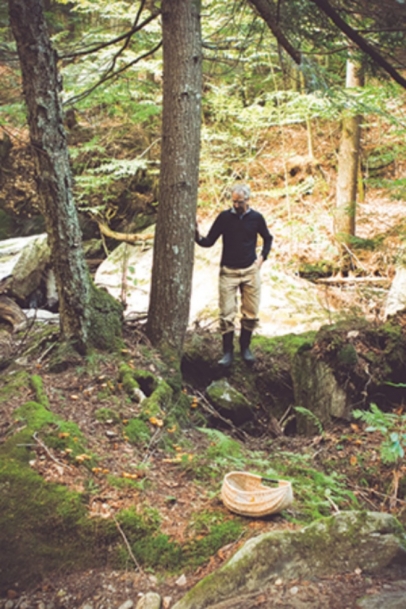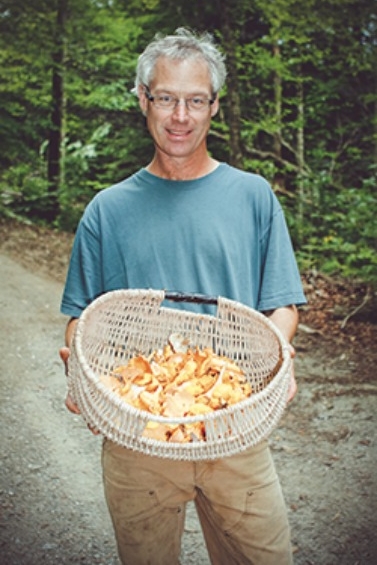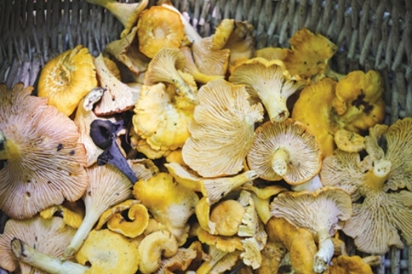Mushroom Hunting with Cranberry Bob
The summer of 2013 was fantastic for wild mushroom hunters. Abundant rain in June resulted in huge flushes of what mushroom lovers call “choice edibles” from the forest floors of Vermont. Several friends showed up at my door with baskets of chanterelles to share along with stories of their finds in local woods.
I grow mushrooms on our farm (shiitakes and oysters) but have always been wary of wild foraging in the woods. My few attempts to find them have been fruitless and frustrating and there is always the nagging thought, ‘What if I pick the wrong one?’ I wanted to go with an experienced forager and so I called the most reliable one I know: Bob Lesnikoski. Though my thoughts were focused on the goal of a big pile of mushrooms to cook up with butter and garlic, I had no idea that foraging was itself a sensory feast.
Lesnikoski is something of a local celebrity. Known to all as “Cranberry Bob,” he is the owner of the Vermont Cranberry Company in Fletcher. Being one of the few large-scale cranberry growers in the state, he has been subject of locavore enthusiasm and media attention for the past decade. Dismissing his notoriety, he demurs, “There’s not much other food news in November” (peak season for cranberry sales). Handsome and looking a decade younger than his 52 years, he has lived in Vermont since moving here from Connecticut in 1979 to attend University of Vermont.
Though managing his cranberry company occupies him year round, like many people in agriculture Lesnikoski wears other hats throughout the year. He has served on the board of the Vermont Fresh Network and is one of the founding members of Pork Club, which, if it needs explaining, celebrates all things pig. He spent many years working as a winemaker and vineyard manager at the Boyden Valley Winery. In the past few years he started Seasonal Seafood, a company that brings seafood to Vermont directly from the docks of New Hampshire and also works part-time as a crew member on one of those boats in the summer. Recently he has been spending time as an engineer for the Liahona, a fishing boat in Cordova, Alaska.
His CV accurately reflects a man whose life is centered around wild and cultivated food and who rarely, if ever, sits still. His favorite off-farm pursuit, however, is to steal time in the summer to forage wild mushrooms, which he sells to restaurants and at the Burlington Farmers’ Market. He is self-taught, having developed a keen interest in mycology during his years at UVM as a forestry student. He learned about wild edibles in a forest pathology course but it is clear that classroom learning only offers a sliver of knowledge; the real learning takes place in a sparsely traversed woods a few days after a good rain. In mid-August 2013 I asked him if I and my friend, photographer Carol Sullivan, could tag along. He graciously allowed us to join him and gave us a 101 introduction to wild mushroom hunting.
Though mushrooms thrive in moist conditions, it is best to pick them on a non-rainy day so they are not harvested in a soggy state. We set out on a cool morning several days after a rain, heading into a forest, alongside a wide creek. (Foragers are notoriously secretive about their hunting grounds and I am not at liberty to reveal our exact location.) The forests of northern Vermont produce many edible mushrooms: chanterelle, morel, lobster, white porcini and black trumpet. Except for morels, which are a spring mushroom, we were on the hunt for all of these, which were destined for the Saturday farmers’ market in Burlington where he sells them for between $16 and $35 per pound.
The first thing to adjust to when looking for mushrooms is to not only look at the ground but be aware of the environment as a whole. Ecological variables will steer you toward the treasure so to forage is to be hyperaware of your surroundings. Black trumpets (Craterellus cornucopia), for example, prefer higher elevations in an oak or beech grove. Chanterelles (Cantharellus cibarius), on the other hand, grow well near a stream under conifers.
In general, mushrooms don’t compete well with ferns but require a more open understory. I found myself trying to look up at tree varieties, down at plant diversity and 30 feet ahead all at once, without tripping over tree roots. I was also becoming very aware of moisture: Was the ground wet underfoot or were there dry leaves crinkling as we went? We walked for a bit without seeing anything, and I was beginning to wonder if the great fungi explosion of 2013 was over. Lesnikoski explained, “The first one is a mind game to see and then you just see them.”
We were soon rewarded when we turned a corner of the stream and found our first small cluster of chanterelles about a foot from the water’s edge. Lesnikoski said that the unwritten rule of foragers is to take only a third of any grouping of mushrooms. It is important to leave some behind to drop their spores for future fruit. He also doesn’t go to any one particular spot more than twice a summer so as not to over-pick the area. It became clear, though, that he was heading toward specific nooks or tree stumps on the forest floor and I could only guess that he has a mental map of past discoveries. He said the week before, in a different forest, he reached into a dead tree, under a ledge on a hunch and found nearly a pound of chanterelles. A hidden spot like that, replete with treasure, is what foragers dream of and has no doubt etched a big red mark on that mental map.
Lesnikoski was correct that after seeing the first group of chanterelles, we saw them everywhere. We found most of them along the stream, occasionally hopping onto islands in the middle where they also thrived. Quite a few were too decayed or nibbled by slugs, which just made the good-quality ones all the more precious. The timing of wild mushroom harvesting—getting to them before bugs or age—was obviously an important factor, but since there was no way to control for this, it just added to the excitement of the chase. We found a strange-looking one called Old Man of the Woods (Strobilomyces floccopus) which was edible but not particularly tasty. Also growing near the chanterelles were some hedgehogs (Hericium spp.), another culinary favorite, which he carefully cut with his knife and added to his paper-lined basket.
One of the mushrooms we found was the Russula emetica also known as the Vomiting Russula. This lovely little red-capped fungus brought up the topic of the dangers of wild-foraging. Lesnikoski says he has never misidentified or gotten sick from a wild mushroom. That said, those who would traipse out into the woods in search of treasure, beware that you can get very sick or even die if you are uninformed about poisonous mushrooms. Varieties such as Amanita bisporigera, aka, the Destroying Angel, which cause liver and kidney failure, are as much a part of the landscape as are the “choice edibles.”
According to the North American Mycology Association, on average, one mushroom-related death is reported every year in the United States and the last available data, from 2009, showed four deaths from Amanita species. Personally, I have always had a macabre fascination with poisonous mushrooms, but if I ever gave someone so much as mild indigestion from a mushroom I picked, I would never forgive myself, so I leave the identifying to more experienced foragers. If you are going to eat mushrooms you found in the wild, triple check with a trusted source that you have found what you think you have.
It was a good day for chanterelles but Lesnikoski really wanted to show us some black trumpets. I wanted to find them too, not only because I had never seen them growing in the wild but also because there is such sinister lore surrounding them. Having nothing to do with poison, they are also called Trumpet of the Dead because they look like trumpets being played by people from underground.
We headed uphill from the stream looking for beech groves and scanned the forest floor, which I found very taxing on the eyes since the trumpets are the same color as the soil. Lesnikoski looked in all the places he had found them in the past but either they eluded us or they were not there. In the hunt, however, we found a white porcini or king boletes. These are a highly coveted mushroom but quite tricky to distinguish from similar looking, inedible mushrooms. It offered a good teaching moment for mushroom classification, though.
To be sure you have the right mushroom, one way to check is to place the cap on a piece of white paper and let it drop its spores. Different varieties will have different-colored spores, which will help you identify them. In the case of the boletes, the spore color should be brown.
“If the spore color is blue,” he explained, “that could be bad.” The spectrum for “bad” with a mushroom is between foul tasting and deadly so I made a personal mental note: boletes—just admire and walk on.
We walked for another half hour looking for black trumpets and just as we were about to give up, Lesnikoski found a hillside where a few of them dotted among the leaves. They maddeningly blended in with the soil underneath, and we all felt triumphant for having found a few at last. They did, indeed, look just a little bit sinister but in the hands of one of Burlington’s celebrated chefs, they will end up as a heavenly treat for some lucky diner. Since his basket was full with one carefully placed layer, we started heading back down the stream to our cars.
We thanked Lesnikoski for letting us tag along for the morning and for giving us some insight to foraging. Carol and I agreed walking along a pristine stream on a perfect summer day was reason enough to try it. The act of searching for mushrooms, however, took the walk to another level as we really studied the details of the forest, intensely focused on the natural world, looking for clues.
It turns out that mushroom hunting is a means of ensuring you do not overlook the minutia of the woods. I noticed details about the soil and plants that I otherwise would have walked past. A basket full of mushrooms may have been our motivation, but a reawakening to the wonderment of the forest turned out to be the bigger reward.









